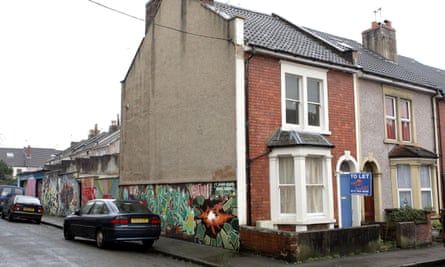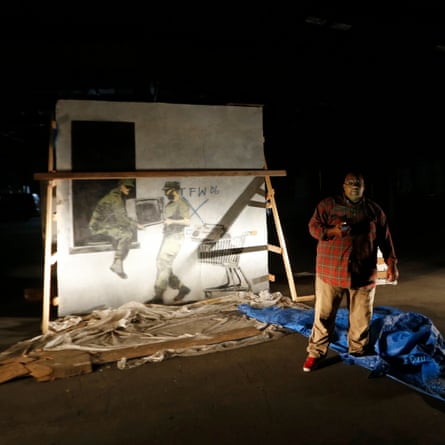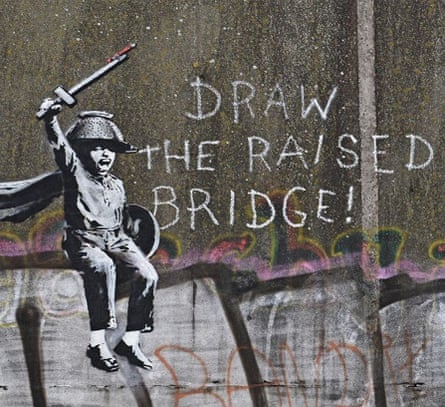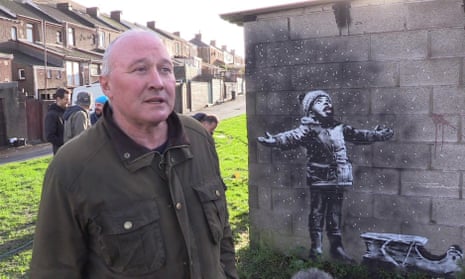After a Banksy mural appeared on his Port Talbot garage last month, Ian Lewis found himself facing a “very, very stressful” battle to protect the artwork from thieves and vandals. Here, four people share their own, very different experiences of being “Banskied”.
“People went, ‘We love the house, but we’re not buying it with that graffiti on it’”
Clik! Clack! Booom, Cato Street, Bristol (2003)
David Anslow, property owner: I had a house in Easton, Bristol – where Banksy used to hang out – which I was renting out to students. One day, one of the students phoned up to ask if his “graffiti artist friend” could do some artwork on the side. I thought it would be pretty cool but didn’t think much more about it. Years later, a friend of ours suddenly said, “Did you know you’ve got a Banksy on your house?” He showed me Banksy’s book, Wall and Piece, and there was our house, with a 32-foot mural on it, the full width of the building. It reminded me of Picasso’s Guernica.
The crazy thing is that at the time we were trying to sell the house, but couldn’t sell it because of the graffiti. People went, “We love the house, but we’re not buying it with all that stuff on the side.” Then we had this bright idea of selling the Banksy and throwing the house in for free as a publicity stunt for the urban art gallery Red Propeller we were starting.

I wanted to make sure any buyer would preserve the mural, but then it all kicked off. The phone started ringing day and night. An Australian offered £400,000. Someone from Los Angeles wanted to take the entire wall to California – the house would have fallen down. When the council sent someone to clean it off, the local people went mad and chased them down the street: we were all very protective of the Banksy. But once the news got round, someone broke into the house, smashed it up and chucked buckets of red paint all over the picture. It was ruined, but then every graffiti artist in Bristol wanted to tag it, so it became this collage of graffiti art, with the remnants of the Banksy still visible.
When it all quietened down, the house sold for around its value: £160,000. Part of the reason Banksy goes incognito is because he got into trouble with the council for defacing public property.
“It doesn’t suck that probably the most famous artist in the world today wants to paint your property.”

Looters, Elysian Fields, New Orleans (2008)
Sean Cummings, property developer: Banksy visited New Orleans in the aftermath of Hurricane Gustav. Through an intermediary I was asked if he could put something on my warehouse, which is on a prominent boulevard. Obviously, it doesn’t suck that probably the most famous artist in the world today wants to paint your property.
I wasn’t told when it would happen, but then the next day people started calling, saying, “Have you seen what’s on your building?” There was this giant mural. Looters isn’t subtle [it depicts two National Guards taking a TV out of a window]. There were reports of looting after Hurricane Katrina and Gustav and he’s obviously channelled that into his wry contempt for authority.

You can draw a line from when [early graffiti artist] Al Diaz and a 19-year old Jean-Michel Basquiat were running around downtown Manhattan and street art was thought of as vandalism but had the beginnings of social commentary, to Banksy.
It’s rare to find someone so creative with both image and text. I love his quotes, such as “The poet produces poems, the painter produces paintings, the criminal produces crimes. If you can do all three at once, you can really confuse the shit out of them.”
I knew Looters was a controversial piece, so we protected it with plexiglass, which failed miserably. Other graffiti artists tagged it, people put placards over it; then it almost burned in a fire. Amazingly, a guy from the New Orleans fire department recognised it as a Banksy and protected it from the blaze. By then there were 11 layers of paint, paper and glue on top of the original work. After midnight one night we cut out that whole section of wall, put it on a tractor trailer and hauled it away for restoration. It took nearly four years after the fire to get back to the original paint. Banksy did 17 pieces in New Orleans – this is one of only three that survived. It’s currently in a warehouse, but we want to allow the piece to spread its message, so in March it goes on display at my International House hotel. We’re going to have to dismantle the entrance to get it in. It’s absurd, I know, but very Banksy.
“I wanted to save it, so headed down there with my ladders.”

Draw the Raised Bridge, Scott Street Bridge, Hull (2018)
Jason Fanthorpe, window cleaner: I live two miles from Scott Street bridge and one night one of the local Facebook groups was buzzing with the news that Banksy had painted it. I’m a keen photographer, so got straight down there. It was an ace atmosphere, with busloads of people arriving and taxi drivers bringing people to see it. I had a tingly feeling looking at the mural, and the thought that Banksy had been to Hull and left a political message about Brexit and division on a disused/raised bridge that separates two halves of the city.

Banksy put it on his Instagram, which verified it as genuine, but on the second night my missus was on Facebook and saw that it had been vandalised. It had been intact for two days, which isn’t bad for a Banksy.
Social media was full of people ranting and raving, but I wanted to do something about it, so headed down with my ladders. It’s a three by four foot mural, but you need ladders to get up to the top. I was hoping the paint would still be wet, but water wouldn’t touch it. Loads of people were turning up to help, so I did the top on my ladders while a girl rubbed at the bottom. We tried white spirit. I didn’t even think “What if it brings off the Banksy?” which is stupid really, but gradually the picture came up underneath: it was magical.
Someone at a local gallery sniffed, “Why don’t they do it on canvas? That’s the place for art”. The council covered it with Perspex, which steams up so you can’t see it, but it’s left a legacy on the city. The Hull Spray Creative asked for permission to turn the whole area into a street art gallery so if you drive around the area now it’s a vibrant mass of ever-evolving graffiti art – because of Banksy.
“The only way he could have painted it was to sail out on a boat”

The Grim Reaper, the Thekla, Bristol (2003)
Pat Somers, senior promotions manager: The story goes that Banksy initially painted the Thekla [a floating vessel live venue] with just a simple “Banksy” tag on the ship’s side, which the harbour master at the time painted over. So Banksy returned to paint the Grim Reaper in a rowing boat, which we believe represents the harbour master.
The Thekla is such a hub for Bristol’s music and creative community that it’s almost certain Banksy would have come to gigs and parties here. He also had his first Bristol exhibition at the nearby Severnshed bar, so was definitely spending time in the vicinity. There’s always been talk that there were also a couple of his famous rat stencils inside the venue at some point, but they were long gone when I arrived in 2006.
Banksy painted the Grim Reaper on the waterside of the moored boat, so the only way he could have done it would have been by sailing out in a rowing boat or something, most likely under cover of darkness. The Reaper is quite large – a couple of metres, and because of its position, it was unlikely to ever be stolen. It wouldn’t just have caused a lot of attention in the harbour, but potentially have sunk the boat! It was probably more hassle than any vandal would be bothered with. But with it being so close to the waterline the big problem was deterioration.
When we renovated the Thekla in the dry dock in 2014, we removed the Grim Reaper to preserve and restore the artwork, and came up with the idea of using the original space for other Bristol street artists. Inkie came to mind immediately due to his connections with Banksy and he was happy to come and paint on the boat while it was still out of the water. The Grim Reaper is now free to view in the M-Shed museum.
Banksy polarises opinion even in his home city, with some seeing him as a vandal, but they’re probably in the minority these days. The Thekla team are very proud of his success and our artwork. It’s an honour to be Banksied.

Comments (…)
Sign in or create your Guardian account to join the discussion